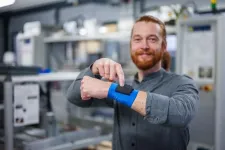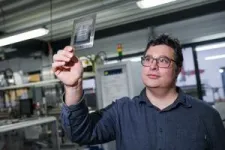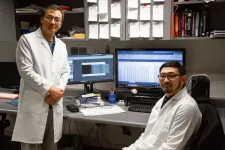(Press-News.org) Clothes that can mimic the feeling of being touched, touch displays that provide haptic feedback to users, or even ultralight loudspeakers. These are just some of the devices made possible using thin silicone films that can be precisely controlled so that they vibrate, flex, press or pull exactly as desired. And all done simply by applying an electrical voltage. The research teams at the Center for Mechatronics and Automation Technology in Saarbrücken (ZeMA) headed by Professors Stefan Seelecke and Paul Motzki (Saarland University) and John Heppe (htw saar – University of Applied Sciences Saar) will be at the international trade fair Hannover Messe, where they will be demonstrating how their smart film actuator technology is being made even more efficient, stable, sensitive and responsive (31 March to 4 April, Hall 2, Saarland Innovation Stand B10).
A research team led by Professors Stefan Seelecke and Paul Motzki from Saarland University are using a highly versatile film not much thicker than household cling film to impart new capabilities to objects while saving energy in the process. When used in wearable textiles, these films can move and press against the skin providing haptic feedback that can enhance the VR gaming experience by allowing players to feel textures, impacts and other physical sensations. When the thin polymer film is integrated into an industrial glove, it can respond to how the operator’s hand and fingers move, thus enabling a computer to ‘understand’ specific hand motions and gestures. Applied to the top of a flat glass display screen, the film can create the transient sensation of a tactile button, switch or slider under the user’s finger. Lightweight loudspeakers that use far less energy than their conventional counterparts, novel signal generators and noise cancelling textiles are just some of the other prototypes being developed by the experts in intelligent materials systems at Saarland University and the Center for Mechatronics and Automation Technology in Saarbrücken (ZeMA).
But how do they bring these films to life? ‘Each side of the film is coated with an electrically conducting layer’, explains Paul Motzki, Professor of Smart Material Systems for Innovative Production at Saarland University and Scientific Director/CEO at ZeMA. When the researchers apply an electric voltage to the polymer film, these electrically conducting layers attract each other, compressing the polymer and causing it to expand out sideways, thus increasing its surface area. ‘By varying the applied electric field, we can control the motion of the film, essentially creating a lightweight but highly efficient actuator,’ says Paul Motzki. The researchers are able to precisely control the motion of these coated films, known as dielectric elastomers (DE), and can get them to perform slow or rapid flexing movements or to vibrate at a desired frequency. Or they can make the film hold a fixed stationary position without requiring the continuous supply of electrical energy.
Using these electroactive polymer films, the research team is developing novel drive systems (actuators) that can be controlled without the need for additional sensors. ‘A precise electrical capacitance value can be assigned to each deformation or change in position of the film. The capacitance data can show us how the film deforms, for example, when it is stroked or tapped by a finger. These dielectric elastomer films are self-sensing and are able to act as their own position sensors,’ explains Paul Motzki. The measurement data is also used to train AI models that enable the researchers to program the motion of the film so that it flexes, holds a desired shape or oscillates at some required frequency.
The team in Saarbrücken are now taking these DE actuators to a new level and opening up a whole host of new applications. The new generation of films can be controlled even more precisely and can vibrate at even higher frequencies. One of the team’s goals is to get these flexible films to oscillate at ultrasonic frequencies. A new project TransDES (Transistor structures based on flexible Dielectric Elastomer Systems), which is being funded by Saarland through the EU's ERDF investment fund, also aims to break new ground by developing elastomeric circuits for high-voltage applications. Printed circuit boards (PCBs) can be found inside most electrical devices. The technology controlling these devices - whether it’s a stand mixer or a smartphone – can usually be found soldered onto flat, rigid PCBs. The research team in Saarbrücken are looking to develop lightweight, flexible PCBs that can be used in the future as low-cost flexible alternatives to conventional PCBs. The flexible circuits being developed in Saarbrücken would also come with integrated miniature, self-sensing actuators.
The TransDES project is a collaboration between Paul Motzki's team at ZeMA and Professor John Heppe’s team at htw saar (University of Applied Sciences). The technology being developed in Saarland is unique worldwide and involves creating elastomeric films with novel electrode layers.
Up until now, the electrically conductive layers were made by applying powdered amorphous carbon (‘carbon black’) to the top and bottom of the polymer film using a screen-printing process. However, the electrical resistance of the carbon black layer is around 10,000 ohms, which is far too high if the film is to vibrate in the ultrasonic frequency range.
By replacing the carbon black layer with an ultrathin metal coating of higher conductivity, the researchers are aiming to create a DE actuator that can be switched on and off at an ultrafast rate. ‘This will allow us to get even better performance from the film,’ explains doctoral student Sebastian Gratz-Kelly. ‘Even at very high frequencies, we are still able to control the entire surface of the film, not just parts of it. But the new ultrathin metal coating also means that the film actuator is more energy efficient and power losses are lower, in part because of reduced contact resistance between the cable and the film. And we’re using a special laser technique that allows us to achieve a much smaller structure size within the coating,’ explains Gratz-Kelly. ‘Previously, when we used screen printing, the distance between the electrodes was around one centimetre. Now, the spacing between the electrodes is only a few micrometres. And this is what’s making it possible for us to design elastomeric flex circuits,’ adds Professor Motzki.
The challenge is that the entire film has to undergo significant stretching, but deformation of the film is hindered by the new metal coating. This is where John Heppe's team comes into play. Heppe, Professor of Physical Sensor Technology and Mechatronics at htw saar, also leads a research group at ZeMA. The two universities are working together to translate their findings into practical industrial and commercial solutions. To balance the properties of a solid metal conductive layer with those of a flexible polymer substrate, Heppe’s team makes use of a special process to deposit the metal layer onto the elastomer. ‘We use a material deposition technique known as sputtering. The conductive layer that we deposit on the surface of the elastomer is only ten nanometres thick, more than a thousand times thinner than a human hair,’ says Mario Cerino, a research scientist in John Heppe's team.
The ‘trick’ the team uses is to stretch the elastomer before they deposit the ultrathin metal layer. Anyone who has ever stuck adhesive tape to an inflated balloon will know the effect. When you let the air out of the balloon, the strip of tape wrinkles. And it is the same with the elastomer film. When the elastomer relaxes, the metal layer contracts forming wrinkles. ‘When we do this, we achieve a resistance of around 50 to 100 ohms over an area of one square centimetre, which is significantly lower than before,’ says Mario Cerino.
The researchers are currently using the metal-coated films to develop energy-efficient and cost-effective silicone-based transistors. Transistors are electronic components that can be used to switch electrical voltages and signals on and off or to amplify them, but in this case the team wants to develop film-based transistors for switching high voltages. ‘By lowering the electrical resistance, we can get more current to flow – just like a kitchen tap lets more water through, the more the tap is opened. This enables us to achieve high-voltage switching with extremely short cycle times, which can be used to control valves, pumps or loudspeakers,’ explains Mario Cerino. ‘We make use of a rather special property of these systems,’ explains Professor John Heppe. ‘If the metal-coated film is stretched more than it was during sputtering, cracks will appear in the electrode layer, which results in a large increase in the electrical resistance. So, if we stretch the film, cracks appear. If we let the film relax, the cracks close up again and the wrinkled structure returns. This allows us to switch from very low resistances to very high resistances, comparable to using a transistor as an electrical switch,’ explains Professor Heppe.
The research team will be demonstrating the technology at this year’s Hannover Messe where they will be exhibiting a new sensor element with a metal-coated film on a textile wristband. This wearable touchpad is a touch-sensitive fabric surface that can recognize shapes that are drawn on it. When someone swipes their finger across this smart textile, the pressure and direction of movement are recorded. Integrated advanced machine learning algorithms then enable the system to recognize the letters or patterns being drawn.
The Saarbrücken-based experts in intelligent material systems will also be showcasing other innovative developments that make use of these self-sensing dielectric elastomers, such as smart textiles and actuators that provide haptic feedback, energy-efficient valves and pumps, and high-performance actuators.
Saarland is funding the TransDES project with around €500,000 from state funds and from the European Regional Development Fund (ERDF).
Read the latest publication from the team: https://doi.org/10.3390/ma17235993
Background:
The dielectric elastomer technology continues to be developed by PhD students conducting research as part of their doctoral dissertation projects under the supervision of Professors Stefan Seelecke, Paul Motzki and John Heppe. The results have been published as papers in a variety of scientific journals. The research work has also received support from numerous sources. Funding from the EU was provided through a Marie Curie research fellowship and from the German Research Foundation through the DFG Priority Programme SPP KOMMMA. The Saarland state government has provided financial support through the ERDF projects iSMAT and Multi-Immerse, and ME Saar (the Association of Metalworking and Electrical Industries in Saarland) has funded a doctoral research scheme. To facilitate the transfer of their smart materials technology into the commercial and industrial sectors, the researchers established the company ‘mateligent GmbH’, which will also exhibiting at the same stand at this year’s Hannover Messe.
https://imsl.de – Intelligent Material Systems Lab
https://smip.science – Chair of Smart Material Systems for Innovative Production
https://imsl.de/projekte – Information and videos on research projects
https://zema.de – Center for Mechatronics and Automation Technology (ZeMA)
END
Smart textiles and surfaces – How lightweight elastomer films are bringing tech to life
Hannover Messe
2025-03-27
ELSE PRESS RELEASES FROM THIS DATE:
FAMU-FSU College of Engineering researchers create innovative microparticles that unlock new insights into protein degradation and immune cell behavior
2025-03-27
FAMU-FSU College of Engineering researchers have created a new method for studying protein degradation within immune cells that uses engineered microparticles to track and analyze degradation processes more effectively than traditional methods.
The work, which was published in ACS Applied Materials & Interfaces, has important implications for treating diseases such as cancer, Alzheimer’s disease and autoimmune disorders.
“There is a lot we still don’t know about how cells ingest and eliminate tissue debris or pathogens — the process ...
Getting the ball rolling
2025-03-27
How gravity causes a perfectly spherical ball to roll down an inclined plane is part of elementary school physics canon. But the world is messier than a textbook.
Scientists in the Harvard John A. Paulson School of Engineering and Applied Sciences (SEAS) have sought to quantitatively describe the much more complex rolling physics of real-world objects. Led by L. Mahadevan, the Lola England de Valpine Professor of Applied Mathematics, Physics, and Organismic and Evolutionary Biology in SEAS and FAS, they combined theory, simulations, and experiments to understand what happens when an imperfect, ...
Breakthrough copper alloy achieves unprecedented high-temperature performance
2025-03-27
A team of researchers from Arizona State University, the U.S. Army Research Laboratory (ARL), Lehigh University and Louisiana State University has developed a groundbreaking high-temperature copper alloy with exceptional thermal stability and mechanical strength.
The research team’s findings on the new copper alloy, published in prestigious journal Science, introduce a novel bulk Cu-3Ta-0.5Li nanocrystalline alloy that exhibits remarkable resistance to coarsening and creep deformation, even at temperatures near its melting point.
“Our alloy design approach mimics the strengthening mechanisms found in Ni-based superalloys,” said Kiran Solanki, a professor at ...
Classroom talk plays a key part in the teaching of writing, study shows
2025-03-27
The way teachers manage classroom discussion with pupils plays a key role in the teaching of writing, a new study shows.
The research shows the importance of managing classroom discussion in a way that develops pupils’ understanding of the choices that writers make, and how those choices create particular effects for readers. This discussion helps pupils to think more about the choices that they make in their own writing.
The study reinforces the importance of dedicating time to discussion in secondary English lessons. It shows that time should be given to exploratory, speculative discussion that ...
Compelling data point to a single, unknown respiratory virus as cause of Kawasaki disease
2025-03-27
Research from Stanley Manne Children’s Research Institute at Ann & Robert H. Lurie Children’s Hospital of Chicago strongly suggests that Kawasaki disease is caused by a single respiratory virus that is yet to be identified. Findings contradict the theory that many different pathogens or toxins could cause this disease that can lead to serious cardiac complications in young children.
“The cause of Kawasaki disease has been a mystery for over 50 years,” said Anne Rowley, MD, pediatric infectious diseases expert and scientist at Manne Research Institute at Lurie Children’s, who is the lead author on the study published ...
Melting ice, more rain drive Southern Ocean cooling
2025-03-27
In brief
Surface waters in the Southern Ocean have been cooling in recent decades, counter to what climate models predict.
Scientists have quantified how much of the cooling observed since 1990 has been driven by an influx of freshwater that’s unaccounted for in state-of-the-art climate models.
The researchers discovered that freshwater inputs along the coast from melting ice sheets exert surprisingly strong influence on Southern Ocean surface temperatures and the broader climate system.
Global climate models predict that the ocean around Antarctica ...
Gasdermin D emerges as a potential therapeutic target for atrial fibrillation
2025-03-27
Atrial fibrillation (AF) is a common form of heart arrhythmia, a serious condition in which the heart beats so fast that its upper chambers, the atria, quiver. This irregular heartbeat can increase the risk of severe conditions, including heart failure, dementia and stroke.
“My lab has been studying the role of inflammation in the initiation and persistence of AF for many years. In this multidisciplinary study, we investigated the function of gasdermin D, a key participant in inflammatory pathways, in atrial heart cells and its potential contribution to AF,” said corresponding author Dr. Na Li, professor of medicine ...
Mapping the Earth’s crops
2025-03-27
As agricultural research continues to become more entwined with technology, smart farming – a phrase that encompasses research computing tools that help farmers to better address issues like crop disease, drought and sustainability – has quickly become a ubiquitous term in Ag labs across the country. The availability of NCSA resources like Delta for researchers, both nationally and on the University of Illinois Urbana-Champaign (U. of I.) campus, has fostered a hotbed of cutting-edge research projects in the agricultural domain.
Yi-Chia Chang, a Ph.D. student at the ...
Rideshare data reveal discriminatory policing for speeding in Florida
2025-03-27
Using data on more than 220,000 individuals on the Lyft rideshare platform, researchers report that drivers of color are significantly more likely to receive speeding tickets than white drivers, and to face steeper fines, even when traveling at identical speeds. Racial profiling by law enforcement is a pressing social issue in the United States. Previous research analyzing police and judicial records suggests that racial and ethnic minorities face disproportionately higher rates of searches, fines, force, detentions, and incarceration compared to white civilians. However, research on racial bias in policing has long been hindered by data limitations ...
Unique genetic mutation underlies horses’ exceptional athleticism
2025-03-27
Researchers have revealed a secret behind horses' exceptional endurance – a mutation in the KEAP1 gene that boosts energy production while protecting against cellular oxidative stress. The findings – which shed light on a unique evolutionary adaptation that has shaped one of nature’s most powerful athletes – hold potential implications for human medicine. They also highlight how the recoding of a de novo stop codon – a strategy thought restricted to viruses – can facilitate adaptation in vertebrates. Long prized for their speed and endurance, horses possess remarkable physiological adaptations ...
LAST 30 PRESS RELEASES:
Post-stroke injection protects the brain in preclinical study
Cardiovascular risk score predicts multiple eye diseases
Health: estimated one in ten British adults used or interested in GLP-1 medications for weight loss
Exercise to treat depression yields similar results to therapy
Whooping cough vaccination for pregnant women strengthens babies’ immune system
Dramatic decline in new cases of orphanhood in Uganda driven by HIV treatment and prevention programs
Stopping weight loss drugs linked to weight regain and reversal of heart health markers
Higher intake of food preservatives linked to increased cancer risk
Mass General Brigham–developed cholera vaccine completes phase 1 trial
First experimental validation of a “150-year-old chemical common sense” direct visualization of the molecular structural changes in the ultrafast anthracene [4+4] photocycloaddition reaction
Lack of support for people on weight loss drugs leaves them vulnerable to nutritional deficiencies, say experts
Dogs’ dinners can have greater climate impact than owners’
Are you ready to swap salmon for sprats and sardines?
1.6 million UK adults used weight loss drugs in past year
American College of Cardiology comments on new dietary guidelines for Americans
American Society of Gene & Cell Therapy and Orphan Therapeutics Accelerator partner to advance and commercialize promising rare disease treatments
One in 14 patients having day case surgery have new or worse chronic pain 3 months after their operation
New study highlights link between eviction rates and gun violence
Heatwaves heat up soil but not toxin levels in rice, study finds
Digital modeling reveals where construction carbon emissions really come from
Turning farm waste into water filters
New study shows how the spleen helps the immune system accept a transplant
New Mayo Clinic study advances personalized prostate cancer education with an EHR-integrated AI agent
Researchers identify novel therapeutic target to improve recovery after nerve injury
Microbes in breast milk help populate infant gut microbiomes
Reprogramming immunity to rewrite the story of Type 1 diabetes
New tool narrows the search for ideal material structures
Artificial saliva containing sugarcane protein helps protect the teeth of patients with head and neck cancer
Understanding the role of linear ubiquitination in T-tubule biogenesis
Researchers identify urban atmosphere as primary reservoir of microplastics
[Press-News.org] Smart textiles and surfaces – How lightweight elastomer films are bringing tech to lifeHannover Messe




